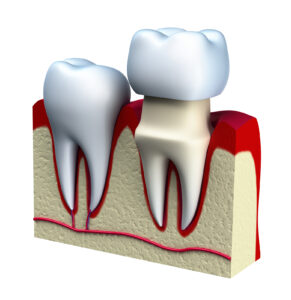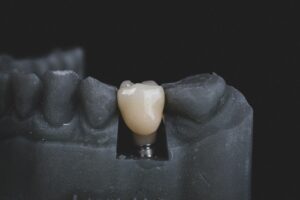The dental crown process is a common solution for restoring damaged teeth. Dentists use crowns to protect weak teeth, cover large fillings, or improve a tooth’s appearance. Understanding each step can help ease any concerns before treatment begins.
Crowns are often recommended when a tooth has significant decay, cracks, or after a root canal. They are designed to look and function like natural teeth, offering durability and protection. Since the procedure involves multiple steps, it’s important to know what happens from the initial consultation to the final placement.
Step-by-Step Breakdown of the Dental Crown Process
Step 1: Initial Consultation and Assessment

Before getting a crown, a dentist will examine the affected tooth. This step is crucial for determining if a crown is the best option. The dentist may take X-rays to check for decay, infection, or structural damage. If the tooth has deep decay or infection, a root canal might be necessary before placing a crown.
Patients will also discuss material choices. Crowns can be made from porcelain, metal, ceramic, or a combination of materials. The right choice depends on factors like durability, appearance, and budget.
Step 2: Tooth Preparation
To prepare the tooth, the dentist will numb the area with local anesthesia. Then, a portion of the tooth’s structure is removed to create space for the crown. If too much tooth structure is missing, a filling may be placed to build it up before reshaping.
Once the tooth is reshaped, an impression is taken. This can be done with traditional molds or digital scanning technology. These impressions help create a custom crown that fits precisely.
Step 3: Temporary Crown Placement
While waiting for the permanent crown, a temporary one is placed over the tooth. This protects it and helps maintain normal function.
Temporary crowns are not as strong as permanent ones, so it’s important to follow care guidelines:
- Avoid sticky or hard foods that could loosen or break the crown.
- Be gentle while flossing to prevent dislodging it.
- Brush carefully, keeping the area clean to avoid irritation.
Step 4: Custom Crown Creation at the Lab
The impressions taken earlier are sent to a dental lab. Skilled technicians craft the permanent crown based on the tooth’s shape, colour, and alignment. This process usually takes one to two weeks.
During this time, the dentist may schedule a follow-up to check on the temporary crown and ensure there are no issues.
Step 5: Final Crown Placement and Fitting
Once the permanent crown is finished, the dentist removes the temporary one. They check the fit, colour, and bite alignment of the new crown before cementing it in place. Minor adjustments may be made to ensure a comfortable fit.
After placement, patients might experience slight sensitivity, but this usually fades quickly. The dentist will provide aftercare instructions to help maintain the crown’s longevity.
How to Care for Your New Dental Crown
A dental crown can last for many years with proper care. While crowns are strong, they still require maintenance to prevent damage and ensure they function well. Good oral hygiene, diet choices, and regular dental visits all play a role in keeping the crown and surrounding teeth healthy.
Daily Oral Hygiene
Maintaining a clean mouth is essential for the longevity of a crown. Even though crowns cannot develop cavities, the natural tooth underneath still can. Follow these steps to keep the area healthy:
- Brush twice a day with a soft-bristled toothbrush and fluoride toothpaste.
- Floss daily to remove plaque buildup around the crown and between teeth.
- Use an antibacterial mouthwash to reduce bacteria and lower the risk of gum disease.
Foods to Avoid
Some foods can put stress on a dental crown. While occasional indulgence won’t cause immediate damage, repeated exposure to certain foods can lead to problems.
- Hard foods – Ice, hard candies, and unpopped popcorn kernels can crack or loosen the crown.
- Sticky foods – Chewing gum, caramel, and taffy can pull at the crown’s edges.
- Sugary foods and drinks – Excess sugar can increase the risk of decay around the crowned tooth.
Routine Dental Visits
Regular checkups allow the dentist to monitor the condition of the crown and the surrounding teeth. Professional cleanings remove plaque buildup that brushing and flossing might miss. If any issues arise, catching them early can prevent complications.
If a crown ever feels loose, becomes damaged, or causes discomfort, contact the dentist promptly. Quick action can prevent further problems and extend the life of the restoration.
Common Questions About the Dental Crown Process
Many people have concerns before getting a dental crown. Understanding what to expect can help ease any uncertainty. Below are some of the most frequently asked questions about the dental crown process.
Does getting a dental crown hurt?
The procedure itself is not painful. Dentists use local anaesthesia to numb the area before any work begins. Some patients experience mild sensitivity or discomfort after the crown is placed, but this typically fades within a few days.
How long does a dental crown last?
The lifespan of a crown depends on the material used and how well it is cared for. On average, crowns last between 10 to 15 years. With proper hygiene and regular dental visits, they can last even longer.
What happens if my crown becomes loose or damaged?
A loose or damaged crown should be addressed as soon as possible. If a crown falls off, avoid chewing on that side and contact a dentist immediately. In some cases, the crown can be re-cemented, but if it is damaged, a new one may be needed.
Can a dental crown be whitened?
No, crowns do not respond to whitening treatments. If discolouration occurs over time, replacing the crown may be the only option to restore its brightness. To maintain a consistent shade, dentists recommend whitening natural teeth before getting a crown.
Conclusion
The dental crown process involves multiple steps, from the initial consultation to the final placement. Each stage ensures that the crown fits properly and provides lasting protection for the tooth. Understanding what happens during the procedure can make the experience smoother and more predictable.
Proper care is essential to maintaining a crown’s longevity. Brushing, flossing, and avoiding certain foods can help keep the restoration in good condition. Regular dental visits including family dentistry in Puyallup allow for early detection of any issues, ensuring the crown continues to function properly.
If you’re considering a dental crown, consult with a dentist to discuss your options. They can evaluate your dental health and recommend the best approach for restoring your smile.
Restore and Strengthen Your Smile with Expert Care
A dental crown can make a significant difference in protecting and restoring a damaged tooth. At Advanced Emerald Dentistry, we ensure every step of the process is smooth, precise, and comfortable. From the initial consultation to the final placement, our team focuses on long-lasting results and personalized care.
Beyond restorative treatments, we offer a full range of dental services designed to support lifelong oral health. Whether it’s preventive care, cosmetic enhancements, or emergency treatments, our skilled team is committed to providing top-quality dentistry in a welcoming environment.
Schedule an appointment today and experience expert dental care with Advanced Emerald Dentistry. Our team is here to help you achieve a healthier, stronger smile.


